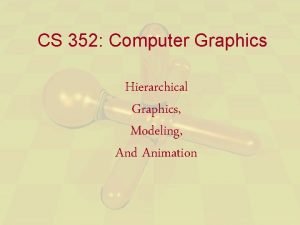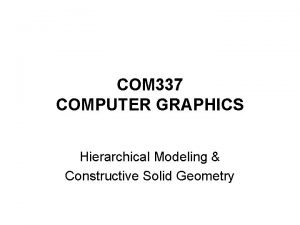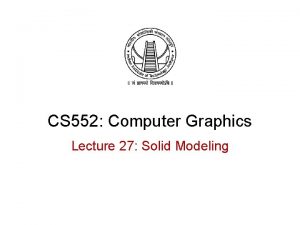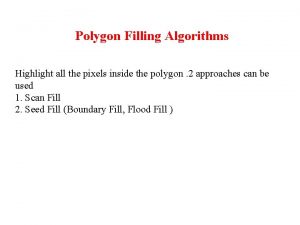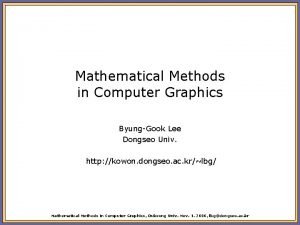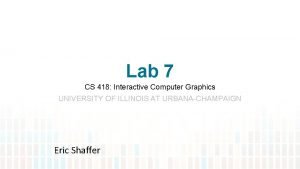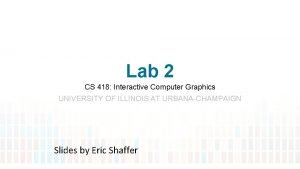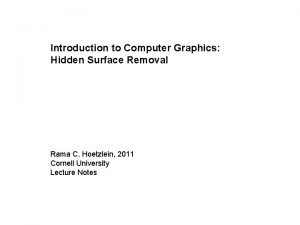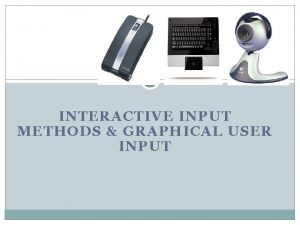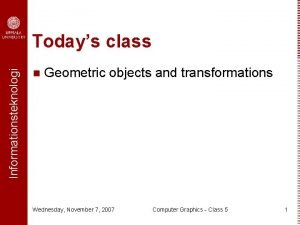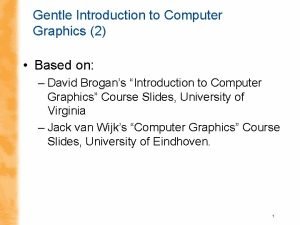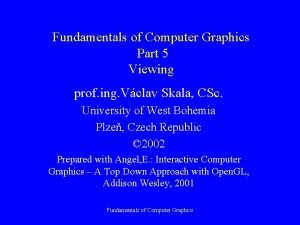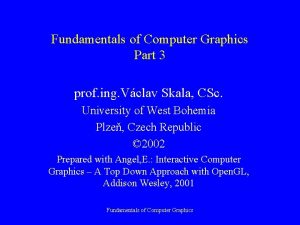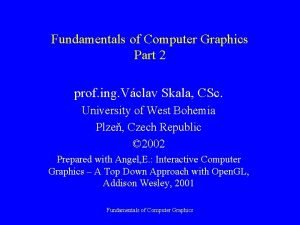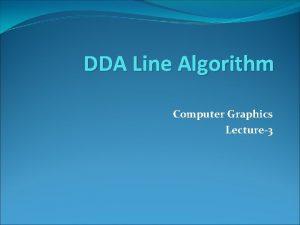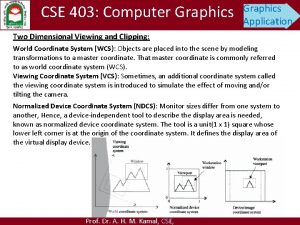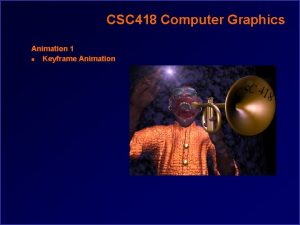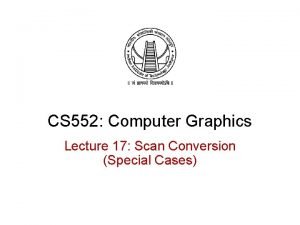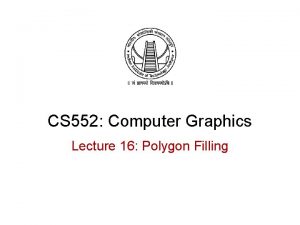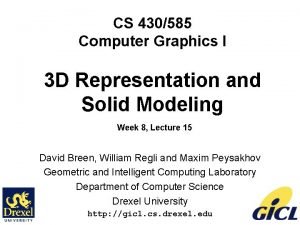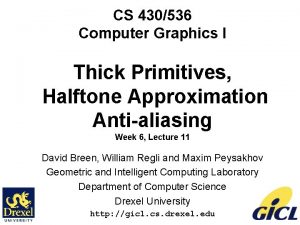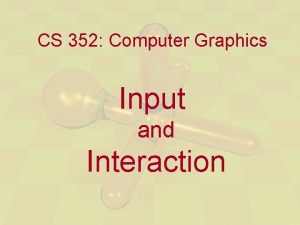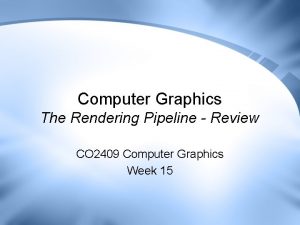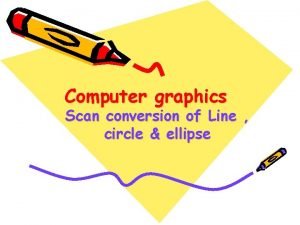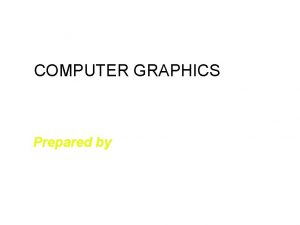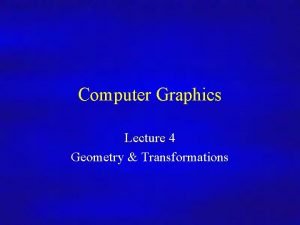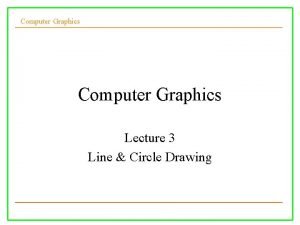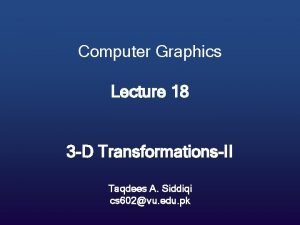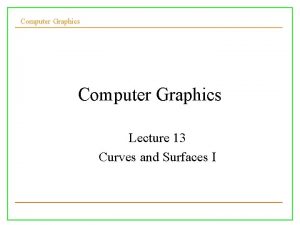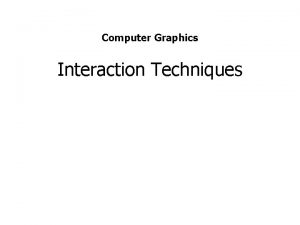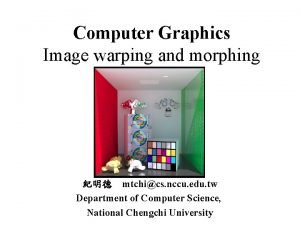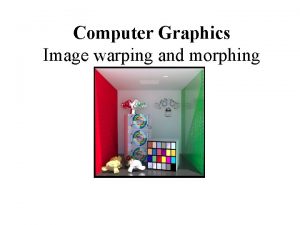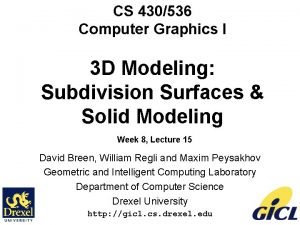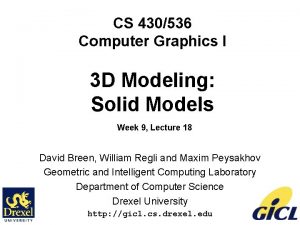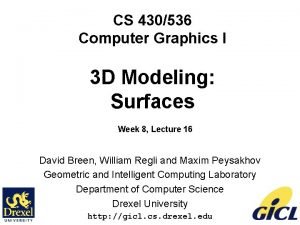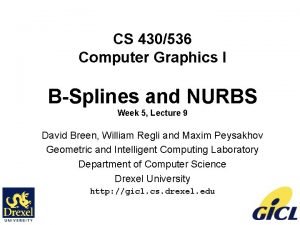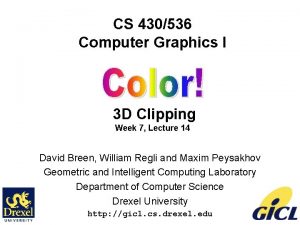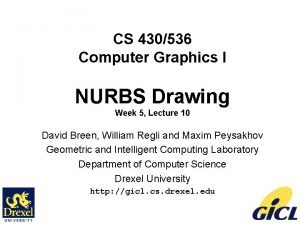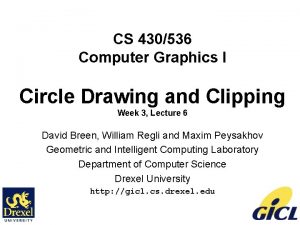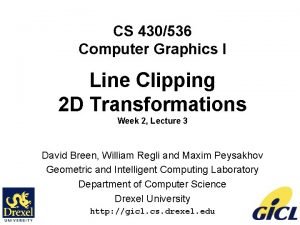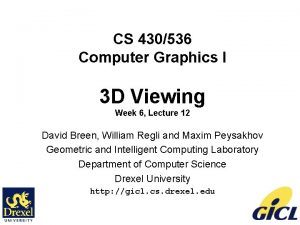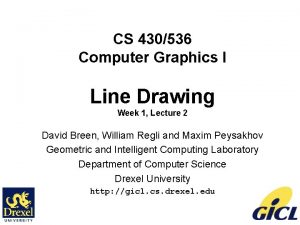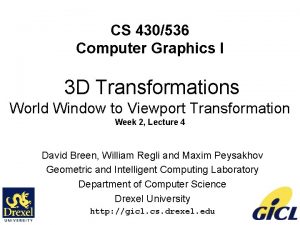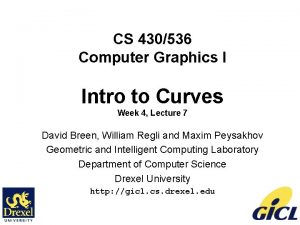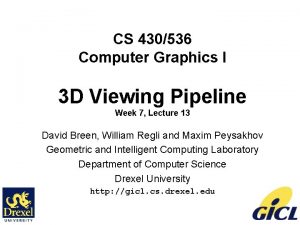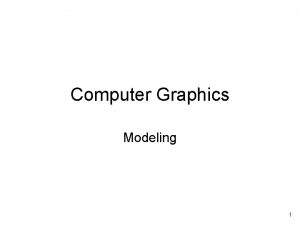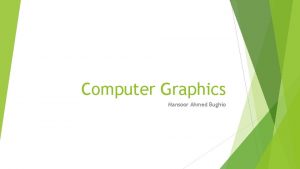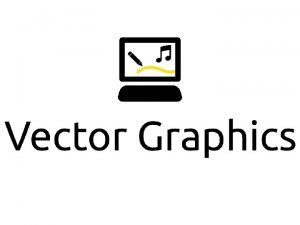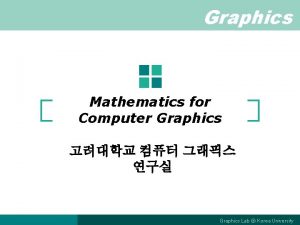CS 430536 Computer Graphics I 3 D Modeling



















































- Slides: 51

CS 430/536 Computer Graphics I 3 D Modeling: Surfaces Week 7, Lecture 14 David Breen, William Regli and Maxim Peysakhov Geometric and Intelligent Computing Laboratory Department of Computer Science Drexel University http: //gicl. cs. drexel. edu 1

Overview • • • 3 D model representations Mesh formats Bicubic surfaces Bezier surfaces Normals to surfaces Direct surface rendering 2 1994 Foley/Van. Dam/Finer/Huges/Phillips ICG

3 D Modeling • 3 D Representations – – – Wireframe models Surface Models Solid Models Meshes and Polygon soups Voxel/Volume models Decomposition-based • Octrees, voxels • Modeling in 3 D – Constructive Solid Geometry (CSG), Breps and feature-based 3

Representing 3 D Objects • Exact – Wireframe – Parametric Surface – Solid Model • Approximate – Facet / Mesh • Just surfaces – Voxel • Volume info • CSG • BRep • Implicit Solid Modeling 4

Representing 3 D Objects • Exact – Precise model of object topology – Mathematically represent all geometry • Approximate – A discretization of the 3 D object – Use simple primitives to model topology and geometry 5

Negatives when Representing 3 D Objects • Exact – Complex data structures – Expensive algorithms – Wide variety of formats, each with subtle nuances – Hard to acquire data – Translation required for rendering • Approximate – Lossy – Data structure sizes can get HUGE, if you want good fidelity – Easy to break (i. e. cracks can appear) – Not good for certain applications • Lots of interpolation and guess work 6

Positives when Representing 3 D Objects • Exact – Precision • Simulation, modeling, etc – Lots of modeling environments – Physical properties – High-level control – Many applications (tool path generation, motion, etc. ) – Compact • Approximate – Easy to implement – Easy to acquire • 3 D scanner, CT – Easy to render • Direct mapping to the graphics pipeline – Lots of algorithms 7

Exact Representations • Wireframe • Parametric Surface • Solid Model – operations – CSG, BRep, implicit geometry 8

Wireframes • Basic idea: – Represent the model as the set of all of its edges • Example: A simple cube – 12 lines – 8 vertices • How about the faces? 9 Foley/Van. Dam, 1990/1994

Issues with Wireframes • Visually ambiguous • No surfaces! – What’s inside? What’s outside? – Hidden line removal? • What does validity entail? – Don’t we just have a bunch of wires? – Do they need to add up to something? • How to model wireframe shapes? – Wire by wire? Not very easy! 11

Surface Models • Basic idea: – Represent a model as a set of faces/patches • Limitations: – Topological integrity; how do faces “line up”? ; which way is ‘inside’/ ‘outside’? • Used in many CAD applications – Why? They are fine for drafting and rendering, not as good for creating true physical models 12

3 D Mesh File Formats Some common formats • STL • SMF • Open. Inventor • VRML • X 3 D 13

Minimal • Vertex + Face • No colors, normals, or texture • Primarily used to demonstrate geometry algorithms 14

Full-Featured • Colors / Transparency • Vertex-Face Normals (optional, can be computed) • • Scene Graph Lights Textures Views and Navigation 15

Simple Mesh Format (SMF) • Michael Garland http: //graphics. uiuc. edu/~garland/ • Triangle data • Vertex indices begin at 1 16

Stereolithography (STL) • Triangle data + Face Normal • The de-facto standard for rapid prototyping 17

How STL Works 18

Open Inventor • Developed by SGI • Predecessor to VRML – Scene Graph 20

Virtual Reality Modeling Language (VRML) • SGML Based • Scene-Graph • Full Featured 21

X 3 D • Open standards file format and run-time architecture to represent and communicate 3 D scenes and objects using XML • Supports – 2 D/3 D graphics, programmable shaders – 2 D/3 D compositing, CAD data, Animation – Spatialized audio and video, User interaction – Navigation, Scripting, Networking, Simulation • See www. web 3 d. org for more info 22

Issues with 3 D “mesh” formats • • Easy to acquire Easy to render Harder to model with Error prone – split faces, holes, gaps, etc 23

BRep Data Structures • Winged-Edge Data Structure (Weiler) • Vertex – n edges • Edge – 2 vertices – 2 faces • Face – m edges 24 Pics/Math courtesy of Dave Mount @ UMD-CP

BRep Data Structure • Vertex structure – X, Y, Z point – Pointers to n coincident edges • Edge structure – – 2 pointers to end-point vertices 2 pointers to adjacent faces Pointer to next edge Pointer to previous edge • Face structure – Pointers to m edges 25

Biparametric Surfaces • Biparametric surfaces – A generalization of parametric curves – 2 parameters: s, t (or u, v) – Two parametric functions 26

Bicubic Surfaces • Recall the 2 D curve: – G: Geometry Matrix – M: Basis Matrix – S: Polynomial Terms [s 3 s 2 s 1] • For 3 D, we allow the points in G to vary in 3 D along t as well: 27

Observations About Bicubic Surfaces • For a fixed t 1, is a curve • Gradually incrementing t 1 to t 2, we get a new curve • The combination of these curves is a surface • are 3 D curves 28

Bicubic Surfaces • Each is , where • Transposing , we get 29

Bicubic Surfaces • Substituting into , we get Q(s, t) • The g 11, etc. are the control points for the Bicubic surface patch: 30

Bicubic Surfaces • Writing out gives 31

Bézier Surfaces • Bézier Surfaces (similar definition) 33

Faceting 34

Plotting Isolines 35

Faceting 36

Bézier Surfaces • C 0 and G 0 continuity can be achieved between two patches by setting the 4 boundary control points to be equal • G 1 continuity achieved when cross-wise CPs are co-linear 37

Bézier Surfaces: Example • Utah Teapot modeled by 32 Bézier Patches with G 1 continuity 38

Bezier Surface: Example • Increased facet resolution • Rendered 39

B-spline Surfaces • Representation for B-spline patches • C 2 continuity across boundaries is automatic with B-splines 40

Normals to Surfaces • Normals used for – Shading – Interference detection in robotics – Calculating offsets for numerically controlled machining 41

Computing the Normals to Surfaces • For a bicubic surface, first, compute the s tangent vector 42

Computing the Normals to Surfaces • Next, compute the t tangent vector: t 43

Computing the Normals to Surfaces • Since s and t are tangent to the surface, their cross product is the normal vector to the surface! • xs - x component of s tangent • ys - y component of s tangent • zs - z component of s tangent 44

Drawing Parametric Surfaces • Usually done “patch by patch” • Two choices – Draw/render directly from the parametric description – Approximate the surface with a polygon mesh, then draw/render the mesh 46

Direct Rendering • Use a scan-line algorithm – Evaluate pixel by pixel – Problem: How to go from (x, y) “screen space” to point on the 3 D patch • Easy for a planar polygon where we know max/min y, equations for edges, screen depth • Not as easy for parametric surfaces 47

Issues for Direct Rendering • Max/Min y coords may not lie on boundaries • Silhouette edges result from patch bulges – Need to track both silhouettes and boundaries • What if they intersect? • Note: patch edges need not be monotonic in x or y • Idea: Scan convert patch plane-by-plane, using scan planes instead of scan lines 48

Direct Scan Conversion of Patches • Basic idea – Find intersection of patch with XZ plane • Producing a planar curve – Draw the curve • De Boor, D’Casteljeau – Note: if doing rendering, one can compute pixelby-pixel color values this way – Patch: x=X(u, v), y=Y(u, v), z=Z(u, v) 49

Patch to Polygon Conversion Two methods: • Object Space Conversion – Techniques • Uniform subdivision • Non-uniform subdivision – Resolution: depends on object space • Image Space Conversion – Resolution: depends on pixels and screen 51

Object Space Conversion: Uniform Subdivision Basic Procedure • Cut parameter space into equal parts • Find new points on the surface • Recurse/Repeat “until done” • Split squares into triangles • Render 52

Object Space Conversion: Non-Uniform Subdivision • Basic idea – More facets in areas of high curvature – Use change in normals to surface to assess curvature • More derivatives – Break patch into subpatches based on curvature changes 53

Image Space Conversion • Idea: control subdivision based on screen criteria – Minimum pixel area • Stop when patch is basically one pixel – Screen flatness • Stop when patch converges to a polygon – Screen flatness of silhouette edges • Stop when edge is straight or size of pixel 54

How do I know if I’ve found a silhouette edge? • If the viewing ray is tangent to the surface at the point it hits the surface! N • L=0 – Where N is the normal at the point where L, the line of sight, hits the surface 55

Silhouette Determination L Xu, et al. , U. of Minnesota N N L = 0 Brenner & Hughes, Brown U. Kowalski, et al. 56
 Computer graphics
Computer graphics Hierarchical modeling in computer graphics
Hierarchical modeling in computer graphics Solid examples
Solid examples Graphics monitor and workstation in computer graphics
Graphics monitor and workstation in computer graphics 3d viewing devices in computer graphics ppt
3d viewing devices in computer graphics ppt Helen c. erickson nursing theory
Helen c. erickson nursing theory Relational vs dimensional data modeling
Relational vs dimensional data modeling Crt in computer graphics
Crt in computer graphics Projection in computer graphics
Projection in computer graphics Plasma panel in computer graphics
Plasma panel in computer graphics Two dimensional viewing
Two dimensional viewing Shear transformation in computer graphics
Shear transformation in computer graphics Glsl asin
Glsl asin Scan conversation
Scan conversation Computer graphics
Computer graphics Region filling algorithm in computer graphics
Region filling algorithm in computer graphics Dda line drawing algorithm
Dda line drawing algorithm Boundary fill algorithm
Boundary fill algorithm In random scan display the frame buffer hold
In random scan display the frame buffer hold Computer graphics
Computer graphics Bresenham's line drawing algorithm example problems
Bresenham's line drawing algorithm example problems Cs 418 interactive computer graphics
Cs 418 interactive computer graphics Glcreatebuffer
Glcreatebuffer Depth sorting method in computer graphics
Depth sorting method in computer graphics Achromatic light in computer graphics
Achromatic light in computer graphics Interactive picture construction techniques
Interactive picture construction techniques Uniform scaling in computer graphics
Uniform scaling in computer graphics Uniform scaling in computer graphics
Uniform scaling in computer graphics Fundamentals of computer graphics
Fundamentals of computer graphics Logical input devices in computer graphics
Logical input devices in computer graphics Fundamentals of computer graphics
Fundamentals of computer graphics Computer graphics chapter 1 ppt
Computer graphics chapter 1 ppt Computer graphics chapter 1 ppt
Computer graphics chapter 1 ppt Differential line algorithm in computer graphics
Differential line algorithm in computer graphics Normalized device coordinate
Normalized device coordinate Keyframe system in computer graphics
Keyframe system in computer graphics Scan conversion in computer graphics
Scan conversion in computer graphics 8 connected boundary fill algorithm
8 connected boundary fill algorithm Utah teapot vertex data
Utah teapot vertex data Thick primitives in computer graphics
Thick primitives in computer graphics Interaction in computer graphics
Interaction in computer graphics Computer graphics pipeline
Computer graphics pipeline Scan conversion of circle in computer graphics
Scan conversion of circle in computer graphics Srgp in computer graphics
Srgp in computer graphics What is translation in computer graphics
What is translation in computer graphics Dda circle drawing algorithm
Dda circle drawing algorithm Uniform scaling in computer graphics
Uniform scaling in computer graphics What are curves in computer graphics
What are curves in computer graphics Input of graphical data in computer graphics
Input of graphical data in computer graphics Active edge table in computer graphics
Active edge table in computer graphics Amber
Amber Warping and morphing
Warping and morphing
